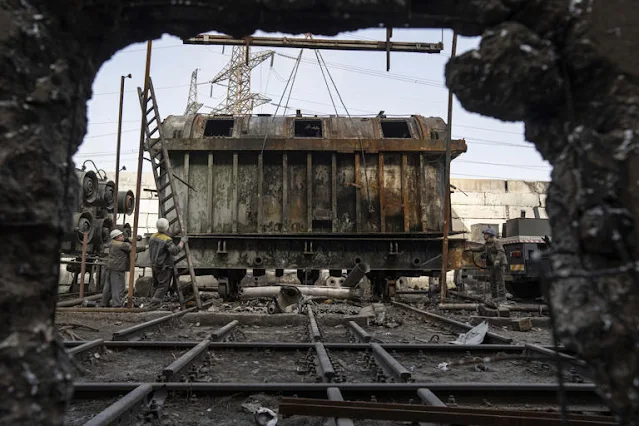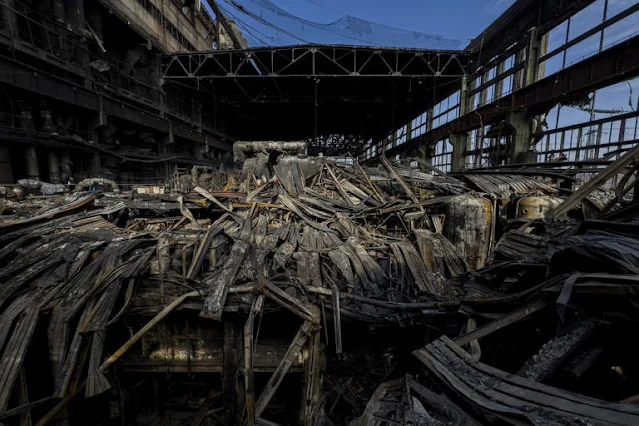When the Russian onslaught struck the Ukrainian power plant, Taras was at the control panel—a critical task that demanded his presence even as the air-raid siren blared and his colleagues fled for safety.
Following the deafening explosions, a cloud of smoke enveloped the area, plunging it into darkness.
Fires erupted, and shrapnel pierced the roof of the vast complex, showering debris onto the workers.
Adhering to protocols, Taras shut down the coal-fired plant, his heart racing. The March 22 attack saw Russia unleash over 60 exploding drones and 90 missiles across Ukraine—the most severe assault on the country’s energy infrastructure since the full-scale invasion began in early 2022
This fusillade underscores Russia's renewed focus on striking Ukrainian energy facilities.
The recent attacks' volume and accuracy have alarmed the country's defenders, who claim Kremlin forces now possess better intelligence and fresh tactics in their campaign to cripple Ukraine's electrical grid and economy.
Moscow has apparently exploited gaps in Ukrainian air defenses. With more assaults expected, officials are scrambling to better defend the country's energy assets.
The March 22 attack, according to analysts, left 1.9 million people without power and stands as one of the most intense in Russia's springtime air campaign targeting civilian infrastructure.
DTEK, Ukraine’s largest private energy company, reported an 80% loss of its power generation capacity in attacks on March 22 and 29, with plants across the country destroyed. Russia also targeted transmission networks.
The bombardment caused widespread blackouts in Ukraine—a level of darkness not seen since the initial days of the full-scale invasion—and tested Ukraine’s ability to make swift repairs.
The Associated Press was granted access to two DTEK power plants damaged in the March 22 attack on the condition that the facilities' names and locations, as well as the workers' full names, not be disclosed due to security concerns.
Technical details of damage, including the number of missiles that struck each plant or whether the plant could still function, were also withheld. Restoring service became increasingly difficult after March 22 due to ongoing strikes that hindered rebuilding efforts.
The Kharkiv region, bordering Russia and hardest hit, continues to endure power outages weeks later. Recently, drones struck the Zmiivska power plant in the region, leaving 350,000 people in the dark. Workers inside the plant gathered debris in wheelbarrows, their faces covered in dust.
Cranes removed large shards of twisted metal and blocks of fallen concrete. In the plant’s dark interior, where an intricate network of pipes connects to industrial boilers, the steel roof was so pockmarked with shrapnel that it resembled a starry night sky.
“I’ve never seen this level of destruction in a power station in my life, and unfortunately, it happened to us,” Timchenko said.
He estimates that the company can restore half of the damaged units in two to three months.
However, workers must repeatedly repair damage, likening the task to the myth of Sisyphus.
This particular plant was targeted late last year, resulting in the destruction of one unit. DTEK had planned to repair it by the end of this year, but the recent attacks have set back those plans significantly.
As Ukrainian officials discuss how to better protect power generators, one solution may involve decentralizing them by creating a network of smaller, harder-to-hit facilities.
Russia typically reserves large-scale attacks on energy infrastructure for the peak winter months when demand for heat is highest. A spring campaign suggests that Russia was behind schedule in implementing new tactics, according to Oleksandr Kharchenko, director of the Kyiv-based Energy Industry Research Center.
Kharchenko believes Russia had initially planned to launch its new tactics a month earlier. While Russia targeted energy infrastructure in the last three months of the previous year, damaging sites were quickly repaired.
By December, Russia acknowledged that its old tactics were ineffective and began devising a new strategy.
“They did extensive intelligence work,” Kharchenko said, citing the precision of the attacks and the thorough knowledge of many energy infrastructure objects, including their defenses, possessed by the Russian military.
Once targets were selected, Russia bombarded them with missiles on an unprecedented scale. Previously, Russia launched three drones and two missiles per target; now, they deploy six missiles and up to 15 drones. Air-defense systems were unable to intercept everything.
"It was too much,” Kharchenko said.
Prior to the March 22 attacks, workers assumed that air defenses would neutralize 70% of air attacks. However, the strikes that penetrated the defenses often landed on the plant's periphery, according to Serhii, a plant manager. "But now the circle is smaller and smaller, reaching our power units and control rooms,” Serhii said.
The consequences are severe.
According to Kharchenko, Ukraine has lost up to 15% of its power generation capacity, leaving it unable to meet the demand expected during the peak summer months of July and August.
For Taras, who was at the power station during the attack, the scale of the destruction was more traumatizing than the explosions themselves.
“I wasn’t scared at first, but we got scared when we saw the consequences,” he said. On the night of March 22, an injured worker was brought into the control room as fires raged across the complex.
“With one hand, we conducted the shutdown, with the other we bandaged his injured leg,” he said. They left the plant using flashlights to navigate through the pitch darkness.
“If the skies were protected, I would feel calmer,” he said. “Power infrastructure is something everything depends on.
If there’s no power, nothing works: Plants don’t work. People are left without internet. You won’t even know when the missiles are flying at you.”


